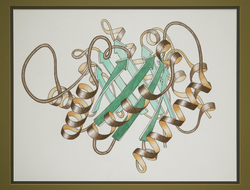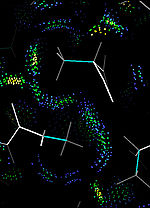
Jane S. Richardson
Encyclopedia


Teaneck, New Jersey
Teaneck is a township in Bergen County, New Jersey, and a suburb in the New York metropolitan area. As of the 2010 United States Census, the township population was 39,776, making it the second-most populous among the 70 municipalities in Bergen County....
) is an American biochemist who developed the Richardson diagram, or ribbon diagram
Ribbon diagram
Proteins are biological macromolecules made up of a long polypeptide chain of amino acids linked by peptide bonds...
, method of representing proteins. She is a professor in biochemistry
Biochemistry
Biochemistry, sometimes called biological chemistry, is the study of chemical processes in living organisms, including, but not limited to, living matter. Biochemistry governs all living organisms and living processes...
at Duke University.
Biography
While attending Teaneck High SchoolTeaneck High School
Teaneck High School is a four-year comprehensive public high school, which is part of the Teaneck Public Schools district in Teaneck, New Jersey, United States...
in 1958, she won third place in the Westinghouse Science Talent Search, the most prestigious science fair
Science fair
A science fair is generally a competition where contestants present their science project results in the form of a report, display board, and models that they have created. Science fairs allow students in grade schools and high schools to compete in science and/or technology activities...
in the United States, with calculations of the satellite Sputnik's orbit from her own observations.
She continued her education in science at Swarthmore College
Swarthmore College
Swarthmore College is a private, independent, liberal arts college in the United States with an enrollment of about 1,500 students. The college is located in the borough of Swarthmore, Pennsylvania, 11 miles southwest of Philadelphia....
, enrolling with the intention of studying mathematics, astronomy and physics. Her bachelors degree is in philosophy with a minor in physics, and she pursued graduate work in philosophy at Harvard University
Harvard University
Harvard University is a private Ivy League university located in Cambridge, Massachusetts, United States, established in 1636 by the Massachusetts legislature. Harvard is the oldest institution of higher learning in the United States and the first corporation chartered in the country...
, receiving her masters degree in 1966. After finding herself unsuited to teaching high school, she joined her husband David C. Richardson, then completing his PhD
PHD
PHD may refer to:*Ph.D., a doctorate of philosophy*Ph.D. , a 1980s British group*PHD finger, a protein sequence*PHD Mountain Software, an outdoor clothing and equipment company*PhD Docbook renderer, an XML renderer...
work at MIT, in studying the 3-dimensional structure
Protein structure
Proteins are an important class of biological macromolecules present in all organisms. Proteins are polymers of amino acids. Classified by their physical size, proteins are nanoparticles . Each protein polymer – also known as a polypeptide – consists of a sequence formed from 20 possible L-α-amino...
of the Staphylococcal nuclease
Micrococcal nuclease
Micrococcal Nuclease is an endo-exonuclease that preferentially digests single-stranded nucleic acids.The rate of cleavage is 30 times greater at the 5' side of A or T than at G or C and results in the production of mononucleotides and oligonucleotides with terminal 3'-phosphates...
protein (1SNS). Her specialty was X-ray crystallography
X-ray crystallography
X-ray crystallography is a method of determining the arrangement of atoms within a crystal, in which a beam of X-rays strikes a crystal and causes the beam of light to spread into many specific directions. From the angles and intensities of these diffracted beams, a crystallographer can produce a...
, and she later began drawing her eponymous diagrams as a method of interpreting the structure of proteins molecules
Protein structure
Proteins are an important class of biological macromolecules present in all organisms. Proteins are polymers of amino acids. Classified by their physical size, proteins are nanoparticles . Each protein polymer – also known as a polypeptide – consists of a sequence formed from 20 possible L-α-amino...
. She has been promoted to many prestigious positions in academia. In July 1985 she was awarded a MacArthur Fellowship for her work in biochemistry. She was elected to the National Academy of Sciences
United States National Academy of Sciences
The National Academy of Sciences is a corporation in the United States whose members serve pro bono as "advisers to the nation on science, engineering, and medicine." As a national academy, new members of the organization are elected annually by current members, based on their distinguished and...
and the American Academy of Arts and Sciences
American Academy of Arts and Sciences
The American Academy of Arts and Sciences is an independent policy research center that conducts multidisciplinary studies of complex and emerging problems. The Academy’s elected members are leaders in the academic disciplines, the arts, business, and public affairs.James Bowdoin, John Adams, and...
in 1991 and to the Institute of Medicine
Institute of Medicine
The Institute of Medicine is a not-for-profit, non-governmental American organization founded in 1970, under the congressional charter of the National Academy of Sciences...
in 2006. She was elected president of the Biophysical Society
Biophysical Society
The Biophysical Society is an organization consisting of over 9,000 researchers in academia, government, and industry. Based in the USA, its international membership has grown to about 1/3 of the total. Founded in 1957 by Ernest C...
in 2010. Richardson is currently a James B. Duke Professor of Biochemistry at Duke University. The Richardsons head a research group at Duke University. As part of her role in the National Academy of Sciences, Richardson serves on panels that advise the White House and Pentagon regarding nationally important scientific matters (e.g.).
Scientific work
Richardson's first forays into science were in the field of astronomyAstronomy
Astronomy is a natural science that deals with the study of celestial objects and phenomena that originate outside the atmosphere of Earth...
. By observing the position of Sputnik – at the time, the only artificial satellite – on two successive nights, she managed to calculate its predicted orbit. She submitted her results to the Westinghouse Science Talent Search, winning third place in 1958.
After earning her masters degree in philosophy, Richardson rejoined the scientific world in the mid 1960s, working as a technician in the same laboratory as her husband. Classes in botany
Botany
Botany, plant science, or plant biology is a branch of biology that involves the scientific study of plant life. Traditionally, botany also included the study of fungi, algae and viruses...
and evolution
Evolution
Evolution is any change across successive generations in the heritable characteristics of biological populations. Evolutionary processes give rise to diversity at every level of biological organisation, including species, individual organisms and molecules such as DNA and proteins.Life on Earth...
that she had taken while pursuing her degree shaped her thinking about the work she was doing in the chemistry laboratory. During her crystallographic studies, Jane Richardson had come to realize that a general classification scheme can be developed from the recurring structural motifs of the proteins. In 1977 she published her results in Nature
Nature (journal)
Nature, first published on 4 November 1869, is ranked the world's most cited interdisciplinary scientific journal by the Science Edition of the 2010 Journal Citation Reports...
, in a paper entitled "β-sheet topology and the relatedness of proteins".
In the meantime, Jane and David Richardson had moved to Duke University
Duke University
Duke University is a private research university located in Durham, North Carolina, United States. Founded by Methodists and Quakers in the present day town of Trinity in 1838, the school moved to Durham in 1892. In 1924, tobacco industrialist James B...
in 1970, where they solved the first crystal structure of superoxide dismutase
Superoxide dismutase
Superoxide dismutases are a class of enzymes that catalyze the dismutation of superoxide into oxygen and hydrogen peroxide. As such, they are an important antioxidant defense in nearly all cells exposed to oxygen...
(2SOD). Richardson had developed the ribbon diagram
Ribbon diagram
Proteins are biological macromolecules made up of a long polypeptide chain of amino acids linked by peptide bonds...
over the course of her taxonomic research. Her iconic images first appeared in the review journal Advances in Protein Chemistry in 1981 (available in annotated form on-line at Anatax), an early hallmark publication in structural bioinformatics
Structural bioinformatics
Structural bioinformatics is the branch of bioinformatics which is related to the analysis and prediction of the three-dimensional structure of biological macromolecules such as proteins, RNA, and DNA...
. They have since become a standard way of visualizing protein structure. Peter Agre
Peter Agre
Peter Agre is an American medical doctor, professor, and molecular biologist who was awarded the 2003 Nobel Prize in Chemistry for his discovery of aquaporins. Aquaporins are water-channel proteins that move water molecules through the cell membrane...
, Nobel laureate and fellow Duke professor, said of the Richardsons' work: "Jane and David’s work allowed us to reveal the form of proteins, and from there it was easier to understand their function."
The Richardsons' more recent work has diversified beyond classification and crystallography. In the 1980s they stretched into the fields of synthetic biochemistry and computational biology
Computational biology
Computational biology involves the development and application of data-analytical and theoretical methods, mathematical modeling and computational simulation techniques to the study of biological, behavioral, and social systems...
as pioneers in the de novo design of proteins. In the '90s they developed the kinemage
Kinemage
A kinemage is an interactive graphic scientific illustration. It often is used to visualize molecules, especially proteins and nucleic acids, although it can also represent other types of 3-dimensional data...
system of molecular graphics and David wrote the Mage program to display them on small computers, for the then-new journal Protein Science
Protein Science
Protein Science is a peer-reviewed scientific journal publishing research on the structure, function, and biochemical significance of proteins, their role in molecular and cell biology, genetics, and evolution, and their regulation and mechanisms of action...
, and they developed all-atom contact analysis (see image) to measure "goodness of fit" inside proteins and in interactions with surrounding molecules. The Richardson Laboratory currently studies structural motifs in RNA as well as proteins, as part of the RNA Ontology Consortium (ROC), acted as assessors in the CASP
CASP
CASP, which stands for Critical Assessment of Techniques for Protein Structure Prediction, is a community-wide, worldwide experiment for protein structure prediction taking place every two years since 1994...
8 structure-prediction experiment (CASP), is one of the four developer teams on the PHENIX software system for x-ray crystallography
X-ray crystallography
X-ray crystallography is a method of determining the arrangement of atoms within a crystal, in which a beam of X-rays strikes a crystal and causes the beam of light to spread into many specific directions. From the angles and intensities of these diffracted beams, a crystallographer can produce a...
of macromolecules, and hosts the MolProbity web service for validation and accuracy improvement of protein and RNA crystal structures. MolProbity uses the KiNG program (successor to Mage) for showing 3D kinemage
Kinemage
A kinemage is an interactive graphic scientific illustration. It often is used to visualize molecules, especially proteins and nucleic acids, although it can also represent other types of 3-dimensional data...
graphics on-line.

